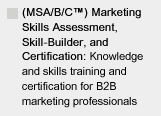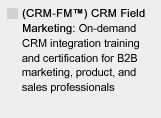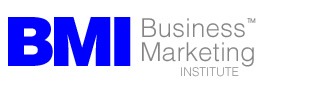MAKE SURE YOU CONTINUE TO RECEIVE EACH ISSUE OF TUESDAY MARKETING NOTES—CLICK HERE TO RENEW YOUR FREE SUBSCRIPTION (IF YOU'VE ALREADY SUBSCRIBED, NO NEED TO RE-SUBSCRIBE)

Developing Content-Based Marketing Programs
for the Post-Marketing Era:
It All Begins With Content—and Here's How to Begin (Part 3)
by Eric Gagnon
Last week, we described the importance of content in the post-marketing era for B2B. This week, we’ll address techniques and idea-starters for creating content for your own content-based marketing programs, and highlight the different types of content that’s usually needed for each stage of the sales process.
Developing a Content-Based Marketing Program: First, Create Your Content
Creating content-based marketing programs is like the recipe for making rabbit stew: “First, catch a rabbit...” The most difficult part is producing the content (i.e., “the rabbit”). Once you do this it’s then much easier to develop the deliverables and programs to highlight, describe, and deliver this content to your market.
Many of us have already learned this lesson from producing Google AdWords keyword search programs, where the content (white paper, report, etc.) that both defines the problem solved by the product, and serves as the object that motivates prospects to provide their contact information to you, is the first deliverable which must be developed, before the text ads, keyword selection, and other necessary execution tasks for the campaign.
To Develop Ideas for Content, Start by Looking Behind Your Product’s Benefits
This process of content discovery is also a process of going behind the sales benefits you’re using in your current marketing program. For example, hidden behind a standard sales copy benefit like: “Higher Speed Operation” are other “stories” you can build a content-based marketing program around:
• What is it about your product’s design, manufacture, and operation that enables it to run at higher speeds, how are these operations unique to your company, and what other problems do these attributes help the prospect solve in his/her business operation or technical application?
• What special technology, processes, design, or skill did your company’s engineering staff incorporate into this product to enable it to operate at higher speeds? How do these knowledge attributes, applied to other aspects of your product’s development, provide other tangible benefits to your prospects, such as lower ongoing maintenance costs?
• Does “higher speed operation” also mean higher output and productivity for your prospect? If so, can you document this higher productivity by developing actual case studies from current customers, comparison with a competitive product, or independently verified testing?
Each of these questions posed, when probing behind a workaday sales benefit like “higher speed operation,” reveals sources and topics for highly effective content-based marketing programs that go beyond the ineffectual marketingspeak into which many conventional B2B marketing programs have devolved, and which most prospects in your market have trained themselves to ignore, now that they can use the Internet to find out just about anything on just about any product. Above all, effective, problem-solving content takes your marketing program to a level of power and positioning that can’t be matched by presenting sales benefits alone in conventional, non-content-based marketing programs.
Forms of Content for Content-Based Marketing Programs
Once you’ve looked behind your product’s sales benefits and answered questions like the ones above, it becomes easier to think about the forms of content you develop to answer these questions.
From our example, the information you develop as content that reaches behind the benefit of “higher speed operation” can be spun out into any or all of the following forms of content:
• A report providing the reader with insights and procedures for calculating payback from their purchase of your product, due to its higher production rates, and highlighting other cost factors to consider;
• A series of industry-specific reports detailing the special challenges, problems, and requirements for product users in each of these industries, and providing guidelines for calculating production rates, payback, and quality criteria in these industries;
• An independent study demonstrating your product’s proven higher productivity, due to its higher operating speed, ranked against competitive products;
• A chart, slide guide, software program, or widget calculating production rates given higher operating speeds
Once you produce the content, you can develop it into any form to suit your marketing application and, most important—the stage of your product’s sales process where this content can benefit you the most.
Content and Your Sales Process: General Topic Idea-Starters
As they learn about products such as yours, potential prospects in your market require progressively different types of content, having different levels of specificity, for different stages of the sales process. This requires you to develop an array of content targeted to the different stages of your product’s sales process:
For Lead Generation
For example, use content in the initial lead generation stage to establish the specialized expertise of your company that makes it unique, to position your company and its product as the prospect’s best solution to their problem. The mere fact that your ad, mailing piece, or other marketing deliverable references substantive content, and not the usual marketing hype seen in the ads run by your competitors, is likely to increase it visibility and impact to readers and viewers in your market.
Here are a few idea-starters to help you begin the process of discovering useful topics for content to use in your own content-based marketing programs for lead generation:
• Your company as industry expert: Position your company as “the expert” who is uniquely suited to be the prospect’s best choice for solving their business problem or issue. Start the conversation not only by providing critical information needed by prospects, but by helping prospects learn to ask the right questions as they apply to researching, evaluating, and selecting products such as yours;
• Highlight a common problem in the prospect’s field, and describe how, when compared to alternative approaches, your company’s technology, process, or application is the best solution to their problem;
• Focus on one technology utilized in your product, provide an overview of this technology that would be useful and of interest, and describe how your company’s expert approach to developing this technology is unique in the prospect’s field, and how the prospect benefits from your company’s expertise and unique perspective;
• Highlight a common industry issue (i.e., automation, compliance, outsourcing, energy efficiency, etc.), describe how this issue challenges companies in your industry, specify the downside of not addressing this issue, describe how companies develop the business case for meeting the challenge posed by this issue, and how your company may be best suited to meet these challenges
For Lead Development
As prospects contact your company, and they become qualified leads in your sales pipeline, their need for content becomes more acute, and more specialized.
First, these potential buyers want to know how your product solves:
• A business problem, such as lagging sales, product liability, or employee turnover;
• A process problem, such as high product defects, component costs, or a system compatibility issue;
• An applications problem, such as achieving a specific, desired result in a step involved in product fabrication, or a “Can your product do this...?” problem
Ultimately, your lead development content must prove how solving a problem produces a measurable result that is compelling to the prospect: Content utilized in lead development that discloses the real, verifiable outcomes of any business, process, or applications problem in quantitative terms—sales increased (and by how much), costs reduced by lowered defect rates, increased production rates due to fewer fabrication steps, etc.—addresses a prospect’s specific interest, based on their conversation with their sales rep at your company. Doing this puts your company solidly in the running as the potential vendor who truly understands, and can solve, the prospect’s problem.
As they move further along in the sales process, potential buyers gain understanding of your product by their interaction with their sales rep and the content you have been providing to them in your lead development program. As they learn more, their information needs become more specialized, more acute, and more diverse, as others in their company often become involved in the purchase decision-making process.
As well, the content you provide to prospects during these later stages must be tailored to these needs:
• What are the critical issues buyers need to know? According to the experts in your company (such as your company’s executives, technical, and product development staff), what are the most critical issues, factors, or other criteria that prospects must consider during their decision-making process involving your product?
• How do these issues affect your prospect’s decision-making process involving products such as yours? Would any of these key issues not be known to most of your average prospects? If so, that’s good—developing these issues as important questions for prospects to consider helps your prospects make better pre-purchase decisions, and gives you more control of their buying process, because you are educating them on the questions they need to be asking. You benefit whenever you help prospects to understand “what to look for” or learn “how to ask the right questions” when making a selection or purchase decision on a product such as yours;
• Is there a “triggering event,” and what is your content response? Triggering events, a term coined by sales expert Jill Konrath, describe material changes in the prospect’s company or business condition that provide a favorable opportunity to close the deal on your product. For example, company mergers, acquisitions, or new business initiatives may create new opportunities to highlight your company’s specialized expertise or other advantages that help the prospect’s company follow through on these events or initiatives. While content must often be highly customized to respond to triggering events, and is often developed specifically on a one-off basis for a prospect, the payoff can be high, especially for major account sales opportunities;
• Who else is involved in the purchase, and what content is required to address their concerns? According to a 2005 study by research firm SiriusDecisons, the average B2B sales cycle is 22% longer, and up to three more decision-makers may now be involved in the prospect’s final purchase process. Often, these decision-makers will be from other areas of the company—Finance, IT, or Manufacturing, for example—and will bring their own issues and concerns to the decision-making process. Your content-based marketing program must have content deliverables ready for your company’s sales team to deliver to advance your product through this process, neutralizing concerns and making the case for your product from the point of view each of these decision-makers.
Content is Hard, But Once Done, It Makes Developing the Rest of Your Marketing Program Easier
If you begin by developing high quality content that is useful and necessary for prospects in your market, it’s easy to communicate the benefits of this content in your marketing program, because the content provides a solid backstop for any copy you’ll be using in the marketing deliverables to present this content.
Once you’ve created the content, your post-marketing era "marketing program" then becomes the vehicle for distributing this content, to make your market aware of this content. The next step is deciding how you are going to do this, and what means you’ll use to present and describe your content so that mildly uninterested and skeptical readers and viewers in your market—your potential prospects—will be motivated to review it.
What do content-based marketing programs look like? What’s the role of social media in content-based marketing for B2B? We’ll take a look next week . . .
Eric Gagnon (eric@realmarkets.net), a director with the Business Marketing Institute, is author of The Marketing Manager’s Handbook and The CRM Field Marketing Handbook, and president of GAA ( http://www.realmarkets.net ), an interactive marketing, turnaround, and product development consulting firm.








